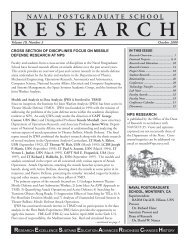Spectral Unmixing Applied to Desert Soils for the - Naval ...
Spectral Unmixing Applied to Desert Soils for the - Naval ...
Spectral Unmixing Applied to Desert Soils for the - Naval ...
You also want an ePaper? Increase the reach of your titles
YUMPU automatically turns print PDFs into web optimized ePapers that Google loves.
BSCs are characteristically located on <strong>the</strong> surfaces of mineral soils and per<strong>for</strong>m<br />
key ecosystem functions in a variety of habitats worldwide and cover ~40% of <strong>the</strong> land<br />
surface up <strong>to</strong> 10cm thick in arid environments (Bowker et al., 2005). BSCs have many<br />
names, cyp<strong>to</strong>gamic, cryp<strong>to</strong>biotic, microphytic, though all imply some commonality. The<br />
difference between cryp<strong>to</strong>biotic crusts and chemical/physical crusts is <strong>the</strong> fact that BSCs<br />
are <strong>for</strong>med by living organisms and <strong>the</strong>ir by-products while chemical/physical crusts<br />
(e.g., salt crusts) are inorganic (Johns<strong>to</strong>n, 1997). These soils contribute <strong>to</strong> carbon and<br />
nitrogen fixation as well as affecting soil moisture and nutrient levels (Bowker et al.,<br />
2005; Evans and Belnap, 1999). In fact, soil texture, pH, and conductivity all play a role<br />
in whe<strong>the</strong>r crusts will be in an area or not (Johns<strong>to</strong>n, 1997; Whit<strong>for</strong>d, 2002). As Prose<br />
pointed out in his study, surface disturbances change intrinsic properties of <strong>the</strong> soil and<br />
can <strong>the</strong>re<strong>for</strong>e be exploited by hyperspectral imagery (Clark, 1999; Prose, 1985). Davis<br />
(2007) made similar determinations about soil water content and vegetation health in his<br />
study on helicopter brown out. It was found that <strong>the</strong> amount of chlorophyll present in <strong>the</strong><br />
soil served as an indication of whe<strong>the</strong>r or not <strong>the</strong> soil was barren (Davis, 2007). It is this<br />
premise that chlorophyll concentrations can be related <strong>to</strong> soil moisture and vegetation<br />
health that should allow <strong>for</strong> detection, using imaging spectrometry, on a sub pixel level of<br />
impact-related surface disturbance; since BSCs are typically at <strong>the</strong> <strong>to</strong>p 1–4 mm of soil<br />
(<strong>the</strong> soil air interface) (Davis, 2007; Johns<strong>to</strong>n, 1997; Weber et al., 2008). Soil-air<br />
interface processes include soil stability and erosion, atmospheric N-fixation, nutrient<br />
contributions, soil-plant water relations, infiltration, seedling germination, and plant<br />
growth (Asner and Heidebrecht, 2002; Johns<strong>to</strong>n, 1997; Webb et al., 2009; Whit<strong>for</strong>d,<br />
2002).<br />
In non-disturbed regions, correlation between soil properties and BSCs can be<br />
made (Whit<strong>for</strong>d, 2002). One correlation is water availability (Weber et al., 2008).<br />
Disturbances generated by impact decrease water infiltration rates in soils and can<br />
register as stress in a biological soil component, fur<strong>the</strong>r supporting <strong>the</strong> idea that BSCs can<br />
be useful in adversary tracking (Prose, 1985; Whit<strong>for</strong>d, 2002). Soil nutrients such as N,<br />
P, K, Mg, Fe, Mn, Zn, Cu, and o<strong>the</strong>rs are also likely fac<strong>to</strong>rs that affect <strong>the</strong> abundance of<br />
cryp<strong>to</strong>biotic soils making <strong>the</strong>m useful in detection of IED supply lines (Smith et al.,<br />
24
















